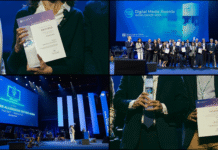I have been reading articles like ‘The Newsroom is Dead. Long live the Newsroom!’ These are about whether newsrooms will be needed after the pandemic and the lockdowns – what will be the shape and style of work to be competitive in publishing. There are articles and discussions about work from near home – the cafe down the street or someplace other than one’s bedroom or kitchen. That editors and journalists must resist the temptation to return to their ‘pre-pandemic rhythms.’
Will newsrooms evolve or be mostly done away with? Many hardcore journalists file stories from the most challenging and unlikely places, but some cannot work from home at all. They need to compare notes with colleagues or have a good argument over a cup of tea or a cigarette to get them going. We used to call publishing groupware but will it have a new dynamic after the pandemic? I talked to a couple of Indian publishers about this – a magazine publisher and the publisher of a daily newspaper.
Even during the lockdown, the magazine publisher is calling all his journalists and staff to the office – “There is no productivity in work from home,” he says.
Although he admits that productivity and accountability are about 50%, the newspaper publisher has a different take, especially since the second wave of the pandemic. However, he adds that his newspaper has saved 15 to 20% in rent, electricity, and letting out two floors of the building not needed, with most journalists and editors working from home.
With the continued uncertainty and talk of a third wave, he says he cannot be sure when the newsroom will be revived and if it will be as large as it was in former days. He says, “The traffic in the big cities is bad, and so is the public transport – we are finding that some of the journalists are writing better stories from home, but it is also a generational thing. My editor wants to see at least an A2 printout of the whole broadsheet newspaper page before he will sign off. He is not comfortable signing off on a PDF on a computer screen. The shape of our newsroom in the future will also depend on the economic recovery, which looks like it is a year away.” New ways of working, accountability, and motivation are needed. We reproduce below a perspective called New Work: an alternative to the traditional world of work.
New Work: an alternative to the traditional world of work
The digital revolution is changing the world as we know it – including the way we work. The job market is now being conquered by a new generation of ‛digital natives’ who have grown up in the age of digitalization and have a sound knowledge of new media. Many employers are trying to recruit young and talented individuals with technological intuition and a firm footing in the digital world. However, this new generation also has different expectations when it comes to their working environment, attaching a great deal of importance to flexible work models, opportunities to work from home, flatter hierarchies and meaningful activities.
The digital revolution has brought about the emergence of a new concept that not only meets the needs of digital natives, but also makes it easier for all employees to balance their private life and career: New Work.
Why New Work? “The time we work is the time we live!”
In the ongoing Covid-19 pandemic, tumbleweed can be seen floating through many open-plan offices and working from home has often been referred to as the “new normal”. Many companies have shown that employees work at least as productively at home as in the office. That’s why working from home is also part of the innovative ‛New Work’ model.
The concept also includes flexible approaches to work, more freedom for people to develop and take on responsibility, greater transparency and a culture of appreciation and trust. In other words, New Work marks a departure from the traditional performance economy, rigid hierarchies and inflexible working time models. Instead, the aim is to merge work and private life in the best possible way.
Some of the essential features of the New Work concept include the promotion of personal responsibility, transparent communication, flextime models, sabbaticals and desk sharing systems. The common goal of all these models is to give employees more flexibility in their everyday lives while boosting their motivation and making them feel appreciated.
However, New Work is not only redefining our working hours and workplace – the focus is also on the development of leadership skills. The aim of New Leadership is to create a feel-good atmosphere at work. According to the New Work theory, managers should move away from rigid hierarchies and adopt the role of coaches. Employers should foster inspiration and motivation as key values to instill a sense of appreciation, trust, mindfulness and other principles in their teams.
But how are companies performing in the field of New Work? As part of the HR Report 2021 by Facts Hays, employees in German-speaking Europe were asked to give their opinion on the current developments within their companies (organizational structure, leadership, corporate culture). When asked whether their company was encouraging employees to develop a sense of personal responsibility, 41% said they fully or somewhat agreed, while 30% stressed that hierarchies were becoming increasingly strengthened. While 38% of respondents said their companies ensured maximum transparency in communication, 34% felt as though their company was remaining silent on critical issues.
What are the requirements for New Work?
If a company wants to implement New Work, they not only need IT infrastructure such as smartphones, computers and software for employees to work flexibly at home or in the office – they also need things like training courses to teach their employees how to use the hardware and software. When establishing New Work within a business, the office facilities should reflect the company’s plan for the workplace – for example, should the office serve as an alternative to employees’ offices at home or as a meeting place for staff? Companies are also developing more agile working methods where independent, interdisciplinary project teams are working in iterations.
Implementation of New Work
The concept of New Work has already been introduced within some companies. In 2020, NEW WORK SE conducted a survey with HR experts and managers from 1,200 German companies. 51% of the companies surveyed were already planning a more flexible workplace design and 14% were looking to facilitate more autonomous work.
ppi Media is also redefining its office workplace. Due to the Covid-19 pandemic, all employees suddenly had to start working from home in March 2020. The past year has proven that ppi Media has all the tools to make remote working a real success. When the company’s employees were surveyed by the management team, they stated that flexible working hours and environments were high on their list of priorities. Instead of keeping the offices spread over two floors, the space will now be reduced to one floor. The managing directors of ppi Media, Dr Hauke Berndt and Manuel Scheyda, point out their reasons for restructuring the layout –
“Offices are acquiring new meaning, as they’re no longer seen purely as workspaces. As a result, employees now expect more from their offices. We also promote the sustainable use of our resources – and empty offices are at odds with this idea. And there’s another point that we find particularly important: We used to be spread over two floors, which were only connected by a public staircase, and this caused our units to be artificially separated. As we’ll now be working together on the same floor, this will also have a positive impact on our communication.”
ppi Media has halved its office space and introduced a new flex desk concept, enabling employees to use a booking system to flexibly indicate whether they need an office workstation or whether they will be working from home.
By restructuring its office space and offering more support to people who wish to work from home, ppi Media wants to promote interaction among colleagues and bring people together who would otherwise rarely meet. The management team is looking to promote the creative, flexible and spontaneous components of co-working. Dr Hauke Berndt and Manuel Scheyda outline the next steps:
“New Work is about so much more than a few flex desks or flexible working hours and locations. It’s about how we want to work together in the future and promoting an anti-mistakes culture, personal responsibility, meaning, creativity and social responsibility. Changing our office set-up may help us develop in one area or another, but we’re the ones who will have to do the hard work in developing ourselves as an organization. Nevertheless, this is a logical step that will boost our agility.”
The core idea of New Work is to promote a mindful return to humanity with a focus on creativity and empathy. Every human being is prioritized and becomes more than just another worker. This gives employees a greater sense of freedom, as their personal needs are taken into account. The term ‛work-life blending’ describes a process where the boundaries between our private and working lives become blurred. Employees can make the most of flexible working models to balance their work and private life as effectively as possible. This also applies to their choice of workplace. In the New Work concept, offices function as co-working spaces where relationships can be built in an environment that best reflects a company’s corporate culture, allowing colleagues to develop and experience a real team spirit.


















